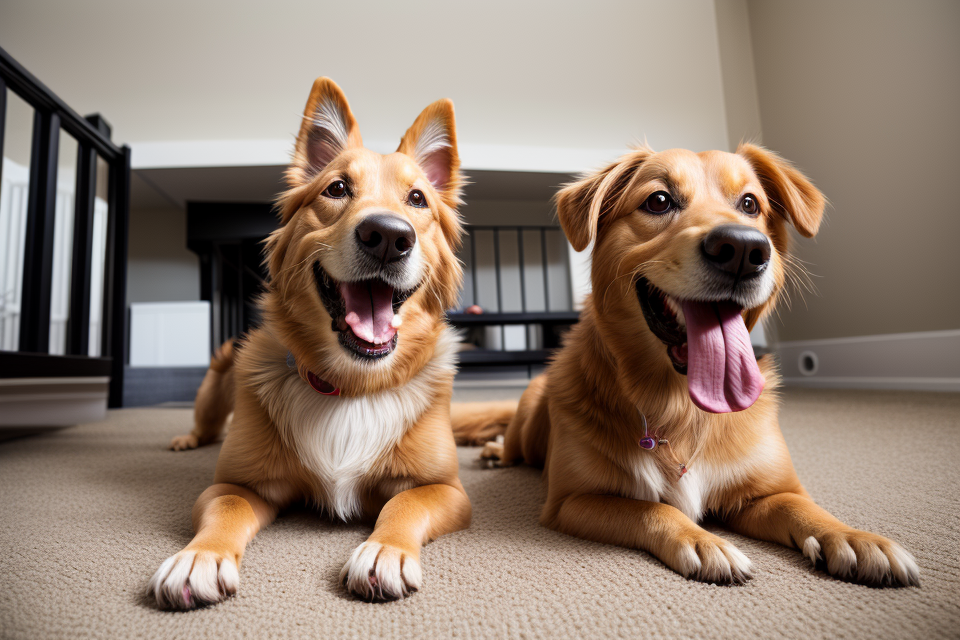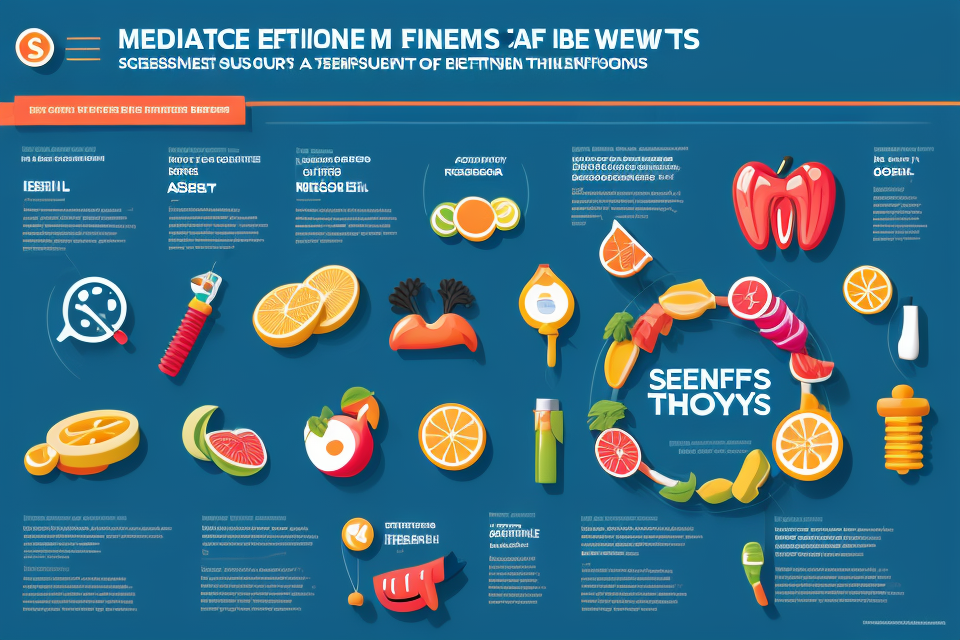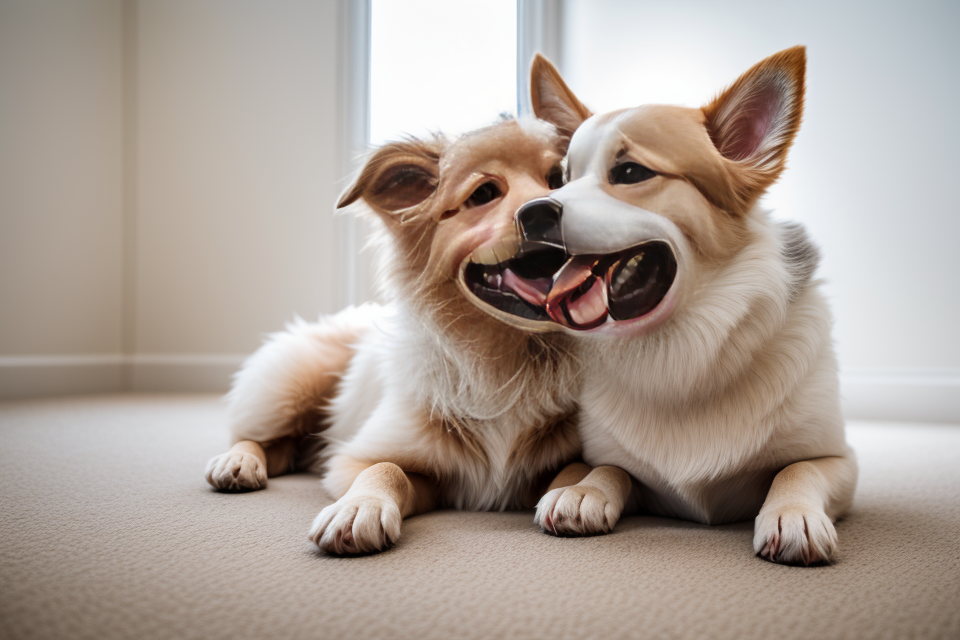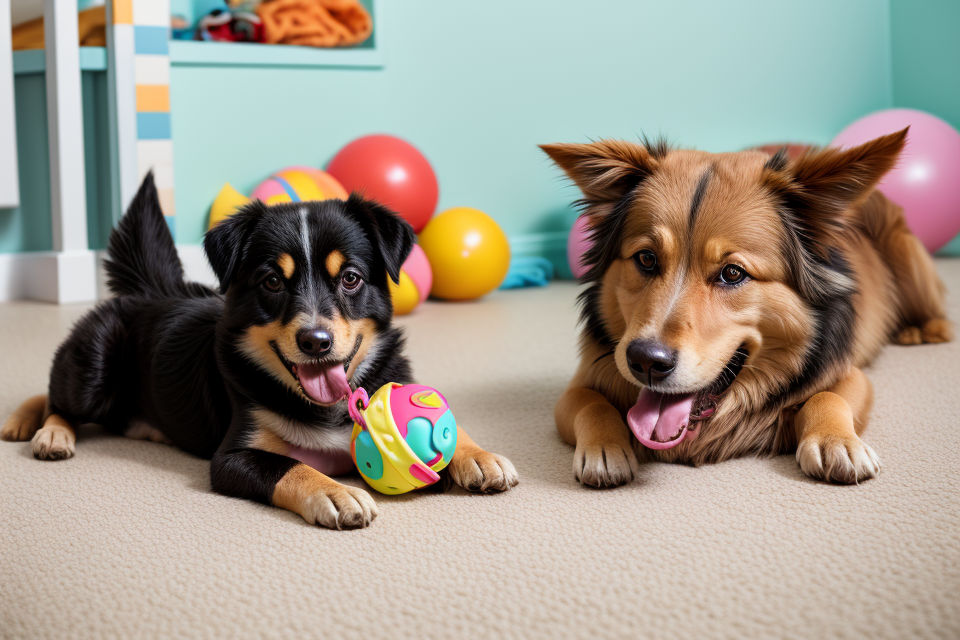Is it okay for my dog to chew on his toys? This is a question that many dog owners ask themselves. After all, dogs are naturally inclined to chew on things, and providing them with toys is a great way to keep them entertained and satisfied. However, some owners may worry that allowing their dogs to chew on toys could damage their teeth or cause other health problems. In this article, we will explore the pros and cons of letting your dog chew on his toys, and provide some tips on how to ensure that your dog is chewing safely.
Yes, it is completely normal and healthy for dogs to chew on their toys. In fact, it is a natural behavior for dogs to chew and it helps satisfy their natural instinct to gnaw and tear. It also helps keep their teeth clean and provides mental stimulation. However, it is important to make sure that the toys your dog is chewing on are safe and appropriate for them. It’s best to avoid toys that are small enough to be swallowed and to choose toys made from durable materials that can withstand a lot of chewing.
Benefits of Dog Chew Toys
Mental Stimulation
Chewing on toys is not only a natural behavior for dogs, but it also provides them with a variety of mental benefits. One of the most significant advantages of dog chew toys is that they can help promote problem-solving skills in dogs. Chewing on toys requires dogs to use their cognitive abilities to figure out how to get the toy apart or to extract the hidden treats. This can help to keep their minds active and stimulated, which is essential for their overall well-being.
Another benefit of dog chew toys is that they can help alleviate boredom. Dogs who are left alone for long periods of time or who do not have access to sufficient physical or mental stimulation can become bored and restless. Chewing on toys can provide them with a fun and engaging activity that can help to pass the time and keep them occupied. This can also help to reduce the likelihood of destructive behaviors such as chewing on furniture or shoes, which can occur when dogs are bored and looking for something to do.
Overall, dog chew toys can provide a range of mental benefits for dogs, including promoting problem-solving skills and alleviating boredom. By providing dogs with access to appropriate chew toys, owners can help to keep their minds active and stimulated, which can contribute to their overall happiness and well-being.
Physical Stimulation
Dogs are naturally inclined to chew on things, and providing them with appropriate chew toys is an excellent way to satisfy this instinct while also promoting their physical health.
- Encourages teeth and gum health: Regular chewing on toys can help remove plaque and tartar buildup on your dog’s teeth, which can prevent gum disease and bad breath.
- Reduces risk of obesity: Chewing on toys can also help satisfy your dog’s appetite, reducing the amount of food they consume and helping to maintain a healthy weight.
It’s important to note that not all chew toys are created equal, and some can be harmful to your dog. It’s crucial to choose toys made from safe materials, such as rubber, rope, or nylon, and to monitor your dog while they chew to ensure they are not swallowing large pieces.
Additionally, providing your dog with a variety of chew toys can help prevent boredom and keep them engaged and entertained. This can also help prevent destructive chewing on household items, such as shoes or furniture.
Overall, incorporating chew toys into your dog’s routine can provide numerous physical and mental benefits, promoting their overall health and wellbeing.
Types of Dog Chew Toys
Rope Toys
Rope toys are a popular choice among dog owners as they are durable and versatile. These toys are made from materials such as cotton, nylon, or rope fibers, which are strong enough to withstand the powerful jaws of a dog. Rope toys can be used for tug-of-war, which is an excellent way to provide mental stimulation and exercise for your dog.
One of the benefits of rope toys is that they can be easily cleaned by washing them in water. This makes them a practical choice for dog owners who want to provide their pets with a variety of toys without having to worry about hygiene. Rope toys are also a good option for dogs who like to chew, as they can satisfy their natural instinct to chew without damaging other household items.
However, it is important to note that not all rope toys are safe for dogs. Some rope toys may have small parts or be made from materials that can be harmful if ingested. It is essential to choose rope toys that are specifically designed for dogs and are made from safe materials.
Another thing to consider when choosing a rope toy is the size of your dog. Rope toys come in various sizes, and it is important to choose one that is appropriate for your dog’s size and strength. A rope toy that is too small or too large can be dangerous for your dog, so it is important to choose one that is the right size for your pet.
In conclusion, rope toys are a great option for dogs who like to chew and play tug-of-war. They are durable, versatile, and can be easily cleaned. However, it is important to choose rope toys that are safe and appropriate for your dog’s size and strength.
Rubber Toys
Rubber toys are a popular choice among dog owners as they are durable, easy to clean, and provide a variety of benefits for dogs.
- Squeaky toys provide auditory stimulation:
Dogs have a strong sense of hearing, and the sound of a squeaky toy can be very appealing to them. Squeaky toys can provide auditory stimulation, which can help keep dogs mentally stimulated and prevent boredom. - Flexible texture is gentle on teeth and gums:
Rubber toys are flexible and can be bent and shaped in different ways, making them gentle on a dog’s teeth and gums. The texture of rubber can help remove plaque and tartar buildup on a dog’s teeth, promoting good oral hygiene.
Additionally, rubber toys come in a variety of shapes and sizes, making them suitable for dogs of all ages and sizes. They are also relatively inexpensive, making them an affordable option for dog owners.
Overall, rubber toys are a great option for dogs who enjoy chewing and playing with toys. They provide auditory stimulation, are gentle on teeth and gums, and come in a variety of shapes and sizes.
Plush Toys
Plush toys are a popular choice among dog owners as they provide comfort and security to their pets. These toys are usually made of soft materials such as cotton, polyester, or nylon, and are designed to be chewed and cuddled.
Here are some benefits of plush toys for dogs:
- Provides comfort and security: Plush toys are soft and cuddly, which can provide a sense of comfort and security to dogs. They can be used as a substitute for destructive chewing, which can cause harm to your dog or your home.
- Encourages positive chewing: Plush toys are designed to be chewed, which can help satisfy your dog’s natural instinct to chew. This can prevent them from chewing on inappropriate items such as furniture or shoes.
- Reduces anxiety and stress: Some dogs may become anxious or stressed due to separation or other environmental factors. Plush toys can provide a sense of comfort and familiarity, which can help reduce anxiety and stress levels.
- Promotes mental stimulation: Plush toys can provide mental stimulation for dogs by encouraging them to use their problem-solving skills. They can also be filled with treats or hidden squeakers, which can add an extra level of excitement and challenge.
When choosing plush toys for your dog, it’s important to consider their size and chewing strength. It’s recommended to choose toys that are appropriately sized for your dog and made of durable materials that can withstand their chewing. It’s also important to supervise your dog when they are chewing on toys to ensure their safety and prevent any choking hazards.
How to Choose the Right Chew Toy for Your Dog
Consider Your Dog’s Size and Strength
When choosing a chew toy for your dog, it’s important to consider their size and strength. The right toy should be sturdy enough to withstand your dog’s powerful jaws, but not so hard that it could cause them to become frustrated or discouraged.
Here are some factors to consider when selecting a chew toy for your dog:
- Dog Size: If your dog is a small breed, such as a Chihuahua or a Toy Poodle, they will likely prefer smaller toys that they can easily carry around in their mouth. Larger breeds, such as German Shepherds or Great Danes, will require larger toys that can provide more satisfaction from their chewing.
- Dog Strength: Some dogs, especially puppies, have stronger jaws than others. If your dog has a strong jaw, they may quickly demolish soft toys or toys made from less durable materials. For these dogs, it’s important to choose toys made from sturdy materials like rubber or nylon.
- Age: Puppies will have different chew toy needs than adult dogs. For puppies, it’s important to choose toys that are designed to be safe for their young teeth and jaws. For adult dogs, you’ll want to choose toys that provide more of a challenge and can help satisfy their natural urge to chew.
Overall, when choosing a chew toy for your dog, it’s important to consider their size, strength, and age to ensure that they are happy and healthy.
Check for Safety Features
When it comes to choosing the right chew toy for your dog, safety should always be your top priority. Here are some tips to help you check for safety features when selecting a chew toy for your furry friend:
- Look for toys that are designed to be indestructible: Dogs can be quite persistent when it comes to chewing, and some toys may not be able to withstand their powerful jaws. Look for toys that are made from durable materials such as rubber, nylon, or plastic, and that are designed to be indestructible. This will help prevent your dog from swallowing or choking on small pieces of the toy.
- Choose toys that are non-toxic and free of harmful materials: Some chew toys may contain harmful materials such as lead, cadmium, or bisphenol A (BPA), which can be harmful to your dog’s health. Make sure to read the labels and choose toys that are non-toxic and free of harmful materials. You can also check with the manufacturer to ensure that the toy is safe for your dog.
- Look for toys that are easy to clean: Dogs can get quite messy when they are chewing on their toys, and some toys may be difficult to clean. Look for toys that are easy to clean and can be washed in water, as this will help keep your dog healthy and happy.
By following these tips, you can help ensure that your dog is safe and happy while chewing on his toys.
Potential Risks of Dog Chew Toys
Choking Hazards
When it comes to dog chew toys, choking hazards are a serious concern for pet owners. Small parts or pieces can easily become detached from the toy during play, and if ingested, they can cause blockages in a dog’s digestive system. This is particularly true for younger dogs who are still learning how to chew and play with toys.
To minimize the risk of choking, it’s important to choose dog chew toys that are designed with safety in mind. Look for toys that are made from sturdy materials and have no small parts that can be easily removed. Chew toys made from rubber or rope are good options, as they are durable and can withstand a lot of chewing without breaking apart.
It’s also important to supervise your dog when they are playing with their toys, especially if they are chewing on them. If you notice your dog struggling to swallow a piece of the toy, remove it immediately to prevent any potential choking hazards.
In addition to choking hazards, it’s important to consider the size of the toy itself. While larger dogs may be able to handle larger chew toys, smaller dogs may have more difficulty handling them and could potentially choke on them. It’s important to choose toys that are appropriate for your dog’s size and chewing ability.
Overall, while dog chew toys can be a fun and engaging way to keep your dog entertained, it’s important to be aware of the potential risks and take steps to prevent choking hazards. By choosing safe and appropriate toys and supervising your dog during playtime, you can help ensure that your dog stays healthy and happy.
Toxicity
Dogs are naturally inclined to chew on things, and providing them with appropriate chew toys is a great way to keep them entertained and satisfied. However, not all chew toys are safe for dogs to consume. Some materials used in the production of chew toys can be harmful if ingested, leading to health problems for your furry friend. It is crucial to choose toys made from non-toxic materials to ensure your dog’s safety.
Some of the toxic materials that should be avoided in dog chew toys include:
- Lead: This heavy metal is harmful to dogs and can cause serious health problems, including anemia, seizures, and even death.
- Arsenic: This chemical can be found in some wooden and plastic toys and can cause a range of health issues, including vomiting, diarrhea, and damage to the liver, kidneys, and heart.
- BPA: This chemical is found in some plastics and can disrupt hormones in dogs, leading to reproductive problems and other health issues.
- Phthalates: These chemicals are found in some plastics and can cause cancer and reproductive problems in dogs.
To ensure your dog’s safety, it is essential to choose chew toys made from non-toxic materials such as:
- Rubber: This material is safe for dogs to chew on and is durable, making it an excellent option for dogs that like to chew.
- Nylon: This material is strong and durable and can be made from non-toxic materials, making it a safe option for dogs to chew on.
- Kong: This brand of chew toys is made from a non-toxic material and comes in a variety of shapes and sizes, making it a popular choice among dog owners.
By choosing non-toxic chew toys for your dog, you can ensure their safety and provide them with hours of entertainment.
Tips for Ensuring Your Dog’s Safety with Chew Toys
Supervise Your Dog
- Monitor your dog’s behavior while they chew on toys to prevent any accidental injuries.
- Pay close attention to your dog’s body language and behavior to detect any signs of discomfort or distress.
- Be alert for any signs of aggression or destructive behavior, and remove the toy immediately if your dog becomes aggressive or starts to destroy the toy.
- Supervision is especially important for younger dogs, small dogs, or dogs with a history of aggression or destructive behavior.
- Consider providing your dog with a variety of chew toys to keep them engaged and interested. Rotating toys can also help prevent boredom and reduce the risk of destructive behavior.
- Always supervise your dog when they are chewing on toys, even if you believe the toy is safe for them. Accidents can happen, and it’s always better to be safe than sorry.
Rotate Toys
When it comes to chew toys, it’s important to keep things interesting for your furry friend. By rotating your dog’s toys, you can help prevent boredom and reduce the risk of destructive chewing on other household items. Here are some tips for rotating your dog’s toys:
- Keep a variety of toys on hand: Rotating toys helps keep your dog engaged and interested in their playtime. To ensure that your dog has a good selection of toys to choose from, keep a variety of different types and textures on hand. This could include rubber toys, rope toys, plush toys, and more.
- Don’t leave toys in the same place all the time: Dogs are creatures of habit and will often go to the same spot to look for their toys. By rotating the location of your dog’s toys, you can help keep them engaged and interested in their playtime. Consider storing some toys in different rooms or hiding them around the house for your dog to find.
- Watch for signs of wear and tear: As your dog plays with their toys, it’s important to keep an eye out for signs of wear and tear. If a toy becomes damaged or shows signs of wear, it’s time to rotate it out and replace it with a new toy.
- Clean toys regularly: In addition to rotating toys, it’s important to clean them regularly to prevent the spread of germs and to keep your dog healthy. Be sure to wash toys with soap and water, and allow them to air dry before giving them back to your dog.
By following these tips, you can help ensure that your dog stays safe and healthy while enjoying their chew toys.
Provide Alternatives
It is essential to provide your dog with alternative activities and items to chew on instead of their toys. This can help prevent them from developing a preference for chewing on inappropriate objects, such as furniture or shoes. Here are some suggestions for providing alternatives:
- Fresh Water: Ensure that your dog has access to fresh water at all times. This can help keep them hydrated and reduce the likelihood of them chewing on inappropriate objects due to thirst.
- Healthy Treats: Provide your dog with healthy treats, such as dog-safe fruits and vegetables, or commercially available dog treats. These can help satisfy their appetite and reduce the likelihood of them chewing on inappropriate objects due to hunger.
- Physical Exercise: Ensure that your dog gets plenty of physical exercise, such as walks, runs, or playtime. This can help reduce their energy levels and reduce the likelihood of them chewing on inappropriate objects due to boredom or restlessness.
- Mental Stimulation: Provide your dog with mental stimulation, such as interactive toys, puzzle toys, or training sessions. This can help stimulate their mind and reduce the likelihood of them chewing on inappropriate objects due to boredom or restlessness.
It is important to remember that every dog is different and may have different preferences and needs. It is essential to supervise your dog when they are chewing on toys or alternative items and to ensure that they are not swallowing any small pieces that could cause choking or other health problems.
FAQs
1. Is it normal for dogs to chew on their toys?
Yes, it is completely normal for dogs to chew on their toys. In fact, it is a natural behavior for them and can be beneficial for their dental health. Chewing on toys can help remove plaque and tartar buildup on their teeth, which can prevent dental problems such as gum disease and bad breath.
2. Are there any downsides to letting my dog chew on his toys?
While chewing on toys is generally a good thing for your dog’s dental health, there are some potential downsides to consider. For example, if your dog is chewing on a toy that is not designed for chewing, it could break into small pieces and pose a choking hazard. Additionally, if your dog is chewing on a toy that has been treated with chemicals or contains small parts, it could be harmful to their health.
3. How can I encourage my dog to chew on his toys?
There are several ways you can encourage your dog to chew on his toys. First, make sure you provide him with a variety of toys that are appropriate for chewing. You can also try giving him treats or rewards when he chews on his toys, as this can incentivize the behavior. Additionally, you can spend time playing with your dog and encouraging him to chew on toys during playtime.
4. What types of toys are best for my dog to chew on?
When it comes to choosing toys for your dog to chew on, it’s important to select ones that are specifically designed for chewing. Look for toys made from materials such as rubber, nylon, or rope, as these are typically the safest and most durable options. Avoid giving your dog toys that are small, hard, or have small parts that could break off and pose a choking hazard.
5. How often should I replace my dog’s chew toys?
It’s a good idea to regularly replace your dog’s chew toys to ensure they are always in good condition. Depending on how often your dog chews on his toys, you may need to replace them every few weeks or months. Look for signs that a toy needs to be replaced, such as if it becomes worn, damaged, or shows signs of wear and tear.



